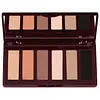What's inside
What's inside
 Key Ingredients
Key Ingredients

 Benefits
Benefits

No benefits
 Concerns
Concerns

 Ingredients Side-by-side
Ingredients Side-by-side

Synthetic Fluorphlogopite
Dimethicone
EmollientMica
Cosmetic ColorantOctyldodecanol
EmollientHdi/Trimethylol Hexyllactone Crosspolymer
Trimethylsiloxysilicate
EmollientDimethicone/Vinyl Dimethicone Crosspolymer
Skin ConditioningSilica
AbrasiveCaprylyl Glycol
EmollientEthylhexylglycerin
Skin ConditioningCI 77891
Cosmetic ColorantIron Oxides
CI 19140
Cosmetic ColorantCI 75470
Cosmetic ColorantCI 77007
Cosmetic ColorantC30-45 Alkyl Dimethicone
Skin ConditioningSorbitan Isostearate
EmulsifyingC20-24 Alkyl Dimethicone
Skin ConditioningPolyglyceryl-2 Tetraisostearate
EmollientCI 77120
Cosmetic ColorantCalcium Aluminum Borosilicate
Calcium Sodium Borosilicate
Tin Oxide
AbrasiveCI 77499
Cosmetic ColorantSynthetic Fluorphlogopite, Dimethicone, Mica, Octyldodecanol, Hdi/Trimethylol Hexyllactone Crosspolymer, Trimethylsiloxysilicate, Dimethicone/Vinyl Dimethicone Crosspolymer, Silica, Caprylyl Glycol, Ethylhexylglycerin, CI 77891, Iron Oxides, CI 19140, CI 75470, CI 77007, C30-45 Alkyl Dimethicone, Sorbitan Isostearate, C20-24 Alkyl Dimethicone, Polyglyceryl-2 Tetraisostearate, CI 77120, Calcium Aluminum Borosilicate, Calcium Sodium Borosilicate, Tin Oxide, CI 77499
 Reviews
Reviews

Ingredients Explained
These ingredients are found in both products.
Ingredients higher up in an ingredient list are typically present in a larger amount.
Caprylyl Glycol is a humectant and emollient, meaning it attracts and preserves moisture.
It is a common ingredient in many products, especially those designed to hydrate skin. The primary benefits are retaining moisture, skin softening, and promoting a healthy skin barrier.
Though Caprylyl Glycol is an alcohol derived from fatty acids, it is not the kind that can dry out skin.
This ingredient is also used as a preservative to extend the life of products. It has slight antimicrobial properties.
Learn more about Caprylyl GlycolCi 75470 is a bright-red pigment. It is AKA carmine.
Carmine is derived from insects such as the cochineal beetle. This ingredient has been used as a natural dye for over 2000 years.
Ci 77891 is a white pigment from Titanium dioxide. It is naturally found in minerals such as rutile and ilmenite.
It's main function is to add a white color to cosmetics. It can also be mixed with other colors to create different shades.
Ci 77891 is commonly found in sunscreens due to its ability to block UV rays.
Learn more about CI 77891Dimethicone is a type of synthetic silicone created from natural materials such as quartz.
What it does:
Dimethicone comes in different viscosities:
Depending on the viscosity, dimethicone has different properties.
Ingredients lists don't always show which type is used, so we recommend reaching out to the brand if you have questions about the viscosity.
This ingredient is unlikely to cause irritation because it does not get absorbed into skin. However, people with silicone allergies should be careful about using this ingredient.
Note: Dimethicone may contribute to pilling. This is because it is not oil or water soluble, so pilling may occur when layered with products. When mixed with heavy oils in a formula, the outcome is also quite greasy.
Learn more about DimethiconeEthylhexylglycerin (we can't pronounce this either) is commonly used as a preservative and skin softener. It is derived from glyceryl.
You might see Ethylhexylglycerin often paired with other preservatives such as phenoxyethanol. Ethylhexylglycerin has been found to increase the effectiveness of these other preservatives.
This ingredient is a powder used to improve texture, slip, and give products a silky texture.
Silica, also known as silicon dioxide, is a naturally occurring mineral. It is used as a fine, spherical, and porous powder in cosmetics.
Though it has exfoliant properties, the function of silica varies depending on the product.
The unique structure of silica enhances the spreadability and adds smoothness, making it a great texture enhancer.
It is also used as an active carrier, emulsifier, and mattifier due to its ability to absorb excess oil.
In some products, tiny microneedles called spicules are made from silica or hydrolyzed sponge. When you rub them in, they lightly polish away dead skin layers and enhance the penetration of active ingredients.
Learn more about Silica